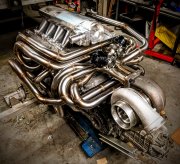Some great, high resolution photos of everything you have done would be an excellent starting point. Have you carefully measured the +/-15V on the test points provided on the control board to see if you have that on both channels? Is your control board a RevE (single set of +/-15V test points) or a RevG1 (2 sets of +/- 15V test points)
I said carefully, don't blow anything up in the process.
Thank you for taking the time to respond.
Electronics have been an On/Off hobby since I was very young. It was my father's favorite past time so I had access to a modest electronics workshop throughout my childhood. Fwiw, soldering was always my favorite thing to do. I don't even remember learning how. My earliest memory of soldering was in the 3rd grade when my dad and I built a Tesla coil for the science fair.
I have not had an opportunity to photograph my project, and, with all due respect, I'd like to move past a visual inspection for just a moment. I'd be happy to circle back after some further discussion.
I took on this project as a way to further my understanding. I learn best when faced with a problem to solve. I have one in front of me now and I would LOVE some direction on what steps to take and in what order. Again, my goal is to learn and self perform the process that an experienced hobbyist follow.
Step 1: Visual Inspection. Look for obvious issues with build quality.
I performed a heavily detailed visual while sorting out a separate issue last month. I will never claim to be 100% sure of anything, however, for now I am confident in my component placement and solder integrity.
Step 2: Double check all measurements and data from Joe's instructions. Here is what I've checked and measured.
B+ to G is ~85v
B- to G is ~85v
15+/- on pre board is spot on
Bias+/- is 370/360 on both channels
No DC voltage on the output terminals
I checked the bias transistors that are clamped to the chassis. I followed a procedure I found online. The results confirmed proper operation but I'm not confident as this was my first time checking a transistor.
Question: Are the Bias test points on the pre-board the same as on the back plains? I assume so because I measure the same values.
This is all I know how to do. Please share with me what YOU would look at next. I have a DMM and a Tektronix scope that I'm dieing to use. I also have a signal generator if that helps.
Here is a better description of the symptoms.
Both Channels sound amazing at low volume, but the right channel is quieter than the left by maybe 25%. Even still, this WO amp is a noticable improvement over the stock 400 I'm currently using.
As I increase the output to 50%, the right channel begins to distort. It sounds like clipping but I'm not certain. Shortly after, around 60% volume the left channel distorts in exactly the same way. The distortion occurs very low in the frequency range meaning the lowest, most demanding notes are affected first. I hate to describe this issue in such simple terms but it feels like the amp runs out of power.
In my very amateur assessment, I've been leaning towards the power supply. The caps are new from WO. The rectifier is original. A 50a rectifier is on order based on advice from another thread.
OMG, as I was writing this, I remembered dropping the transformer HARD last summer. I'd completely forgotten about that.
Tomorrow I'll swap it out for one that's proven to work. In the meantime, I'd love to hear some input.
Thanks for listening!!

